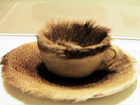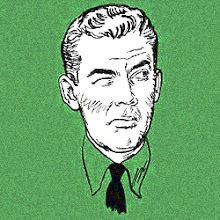 G. David Thompson, a Pittsburgh millionaire, 61 years old in 1960, had been collecting modern art for twenty-five years by then. Klees and Giacomettis were all around the house. He owned Leger's Composition with Three Sisters. And a Juan Gris still-life: "A friend of mine owned this," he said of the Gris. "He was dying to buy a Braque but didn't have the ready cash so I bought this to help him out. No great favor--I liked the painting." At least one Mondrian. And so on.
G. David Thompson, a Pittsburgh millionaire, 61 years old in 1960, had been collecting modern art for twenty-five years by then. Klees and Giacomettis were all around the house. He owned Leger's Composition with Three Sisters. And a Juan Gris still-life: "A friend of mine owned this," he said of the Gris. "He was dying to buy a Braque but didn't have the ready cash so I bought this to help him out. No great favor--I liked the painting." At least one Mondrian. And so on.In '59 he offered the entire collection to the city of Pittsburgh, and he threw in the house too - which the city, he said, could use as a ready-made museum.
Pittsburgh said no. Not interested. Thanks, but no thanks.
Angry and lovin' a deal, Thompson promptly sold 97 - that's 97, yes - of his Klees to a dealer for more than $1 million, and then began to buy little-known moderns. After selling the Klees, he said: "I want to enjoy once more the pleasure of bare walls waiting for new pictures."
(In '61 the Guggenheim put up a show called "One Hundred Paintings from the G. David Thompson Collection." It's easy, especially now, to gloat about the wisdom of the Guggenheim people or of the New York museum-going public: they, after all, wanted what Thompson was doing. This entry isn't meant to speak one way or the other to that. Rather, I'm thinking about what happens when a philanthropic gesture is undervalued or misunderstood. What does the philanthropist do in response? After all, he or she is typically - let's admit it - someone who is used to getting his or her way. Is pique the right reaction? Was Thompson perhaps in the wrong place? Or is it apt for him to stick it out, hoping for a better day?)
Above: Leger's "The Compass" (1926). Thompson bought this Leger from Buchholz Gallery in New York in 1953. He owned it for the rest of his life. It was sold by Parke-Bernet in '66 after Thompson's death in '65. It is now at the Art Institute of Chicago.
sources: Life May 16, 1960, with a great spread of photos from the collection; an article in Time, Jan 13, 1961.

 Is '60 the moment when the end of the end of the Old Left had been reached and the New Left began to emerge? Is it the final ascendancy, in certain scenes at least, of poetic postmodernity? Surely the publication of Donald Allen's The New American Poetry that year suggests this, but then again--once again--we look back on "New" here and see continuity. The rhetoric of the Kennedy-Nixon contest made much less of a dent than everyone (at the time as well as since) claimed, so one wonders why were such great claims made?
Is '60 the moment when the end of the end of the Old Left had been reached and the New Left began to emerge? Is it the final ascendancy, in certain scenes at least, of poetic postmodernity? Surely the publication of Donald Allen's The New American Poetry that year suggests this, but then again--once again--we look back on "New" here and see continuity. The rhetoric of the Kennedy-Nixon contest made much less of a dent than everyone (at the time as well as since) claimed, so one wonders why were such great claims made?  Had we come to expect "1960" to be truly ubiquitously modern in a way that the 1950s really were not--not quite? And what specifically does "modern" mean in the Kennedyesque talk then and now about the torch being passed to a new generation, etc.? The First Lady really meant "modernist" when Camelotians said "modern." What about the others across the new young cultural leadership? I've been surprised by how frequently the
Had we come to expect "1960" to be truly ubiquitously modern in a way that the 1950s really were not--not quite? And what specifically does "modern" mean in the Kennedyesque talk then and now about the torch being passed to a new generation, etc.? The First Lady really meant "modernist" when Camelotians said "modern." What about the others across the new young cultural leadership? I've been surprised by how frequently the  "Beat movement" was covered in 1960 in the mainstream press. I was expecting a fair measure but I've found tonnage. 1960 was the year when the figure of the beat was beginning to find acceptance, although still 80% of these stories are mocking, rebels-without-cause condescension. For anyone whose analysis made an impact nationally, do these antipolitical adolescents count as part of the "new young cultural leadership"? No, but rather than the two being opposites, they fall along a Continuum of the New American. Now that's a change for '60.
"Beat movement" was covered in 1960 in the mainstream press. I was expecting a fair measure but I've found tonnage. 1960 was the year when the figure of the beat was beginning to find acceptance, although still 80% of these stories are mocking, rebels-without-cause condescension. For anyone whose analysis made an impact nationally, do these antipolitical adolescents count as part of the "new young cultural leadership"? No, but rather than the two being opposites, they fall along a Continuum of the New American. Now that's a change for '60.







